By María Eugenia Alonso, Mar Borobia y Dolores Delgado
The selection of paintings on this tour highlights some of those great little moments in life captured in figures that feature in the Museo Nacional Thyssen-Bornemisza’s collections. Many of these moments are linked to leisure pursuits or celebrations where diversions – either planned or spontaneous – are a welcome break from routine, and provide enjoyment and happiness.
Among these pleasures, music has a special place, featuring on the canvases of artists like Bologna’s Giuseppe Maria Crespi, where it reveals the refined tastes of the sitter, or of Johan Zoffany, where it livens up a family party. Music, poetry, courtship and theatre, all out of doors, are the choices of Jean-Antoine Watteau for his garden gathering. Play is another common pastime shown, represented on this itinerary by the singular game of cards depicted by Lucas van Leyden. Taverns and tavern life was a subject that also appealed to artists; David Teniers II explores the pleasure of pipe-smoking and sharing the moment in company. The rigours of winter are no excuse for the characters in the painting by Jan Josephsz. van Goyen who make the frozen river an attractive spot for sledging and skating. Nor is the heat an impediment for the young people depicted by Jean-Honoré Fragonard as they turn a tree branch in dense woodland into the perfect opportunity to swing high up into the air during an exciting day in the country. Free time can also be devoted to cultural activities which stimulate the senses in works of art like Pieter Hendricksz. de Hooch’s oil painting. These leisure moments can also be used for matters of the heart, as shown by the François Clouet painting included here, or for a harmless prank to lighten up a dull afternoon, as presented in the oil painting by Pietro Longhi.
Tour artworks
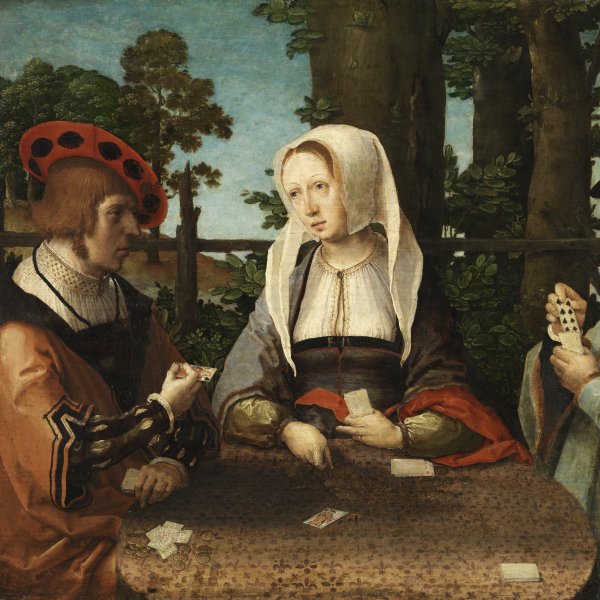
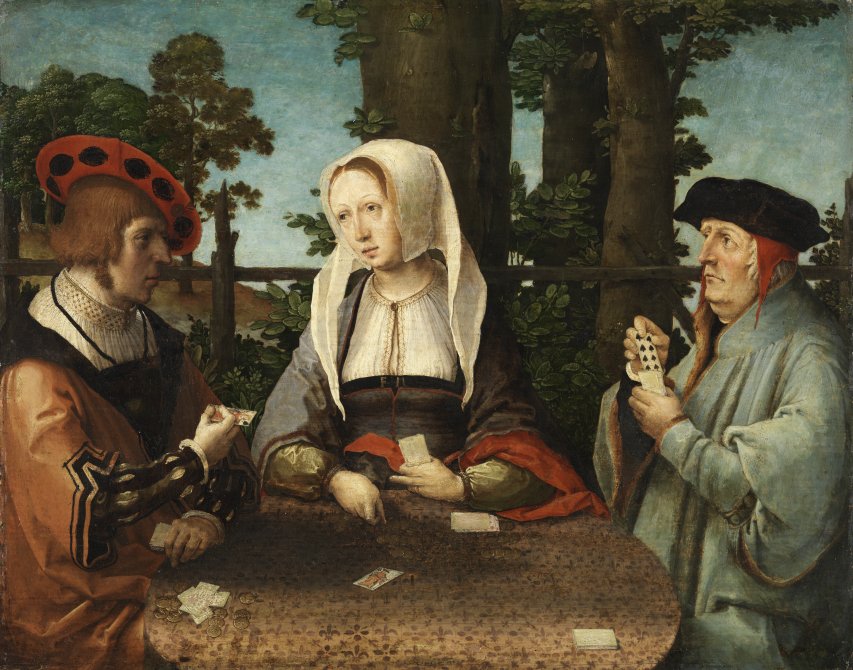
Lucas van Leyden
The Card Players
ROOM 10
Card games were probably invented in East Asia, arriving in Europe at the end of the Middle Ages. There are many legends as to the origin of these games, almost all of which are linked to recreation and magic. There is also dispute as to whether they originated in India, China or Egypt, although it is widely held that they emerged in 12th-century China. From that point on, their usage spread all over Europe, which led to the different deck formats found in different countries. Indeed, cards were so successful they were even banned during certain periods. However, it was not until the 16th century that they were popularised and became a regular subject in painting. Card games have played a significant role in the history of art ever since. The Dutch artist Lucas van Leyden was one of the first to depict them during the Renaissance before they had become such a common theme. The Baroque period was a high point in the representation of card play which became a recurring theme in the work of major artists like Italian genius Caravaggio and France’s Georges de La Tour. Later, in the 19th and 20th centuries, it also features on the canvases of masters like Cézanne and Otto Dix.
In this work, Van Leyden presents us with three people playing cards, using a deck on which, as was usual at the time, the figures represent heroic characters. The work has been interpreted in two different ways. The first considers it an allegory of love in which the figure on the left holding the king of spades will be the winner; the second interpretation gives the work a political slant and identifies the same man as Emperor Charles V, the woman as his aunt, Margaret of Austria, regent of the Low Countries, and the third as Cardinal Thomas Wolsey, ambassador of Henry VIII of England, all supposedly portrayed plotting against France and its monarch Francis I.
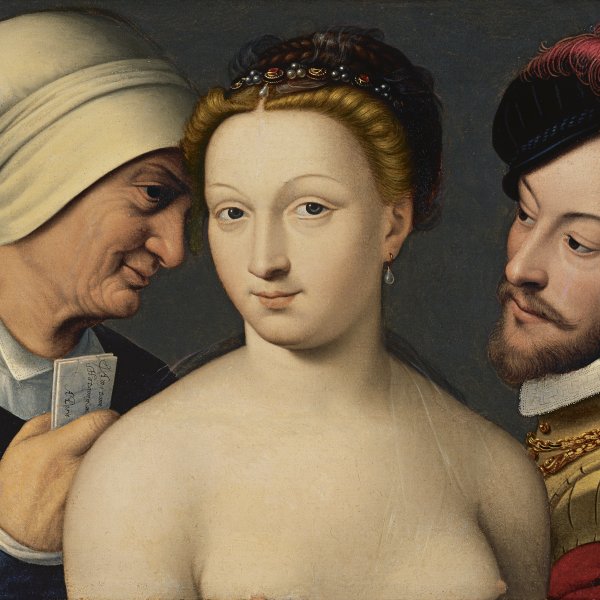
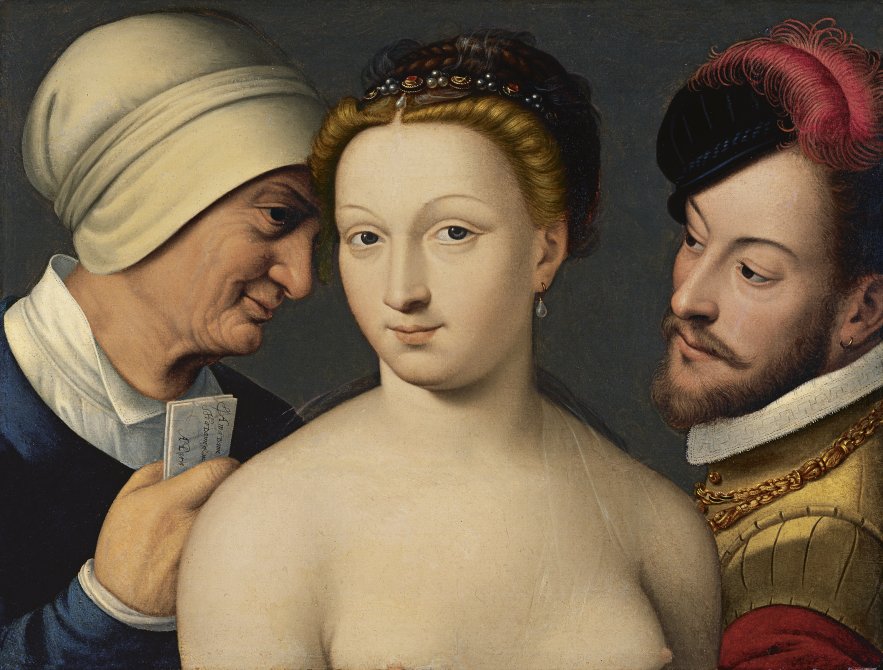
François Clouet
The Love Letter
ROOM 6
François Clouet was one of the outstanding painters of the French Renaissance. His works have a highly personal style, influenced by Italian and Flemish painting, and more specifically by the School of Fontainebleau. He was particularly highly regarded for his court oil portraits and drawings.
The three figures on this small panel appear to be taken from a scene of the famous Commedia dell’Arte, a form of popular theatre that began in Italy in the 16th century and soon became hugely successful in France. With simple plots, it usually dealt with the amorous affairs and misfortunes of couples in love. Here, Clouet places the young woman and object of affections in the centre of his composition, covered only by a transparent veil, and looking outwards with an ambiguous, congenial expression as if seeking the viewer’s complicity. Beside her is the procuress, an old woman holding a folded letter on which we can read the words “A ma Dame Ma Dame Luc … A Paris”, written perhaps by the lover, a man dressed in keeping with prevailing 16th-century fashions, sporting an earring and carefully-trimmed beard, who gazes, enraptured, at the young woman. The exchange of glances creates a sensual tension and turns us into voyeurs of the secret plot being played out before our eyes.
The theme of love letters or billet doux —first depicted in French painting in the 16th century, partly because of the development of the postal service— gained popularity in 17th-century Netherlands, with well-known examples like Vermeer’s Love Letter (ca. 1669), held by the Rijksmuseum in Amsterdam, and later, in 18th-century France with paintings by François Boucher, Jean-Honoré Fragonard and Jean-Baptiste-Siméon Chardin. Considered genre scenes, these paintings usually depict a female figure receiving or reading a love letter in a domestic interior. Thus, the letter becomes a secret element between the figure holding it and the viewer, creating an atmosphere of mystery and sometimes revelation, when the painter leaves part of it legible, inevitably leading us to try to piece together the story.

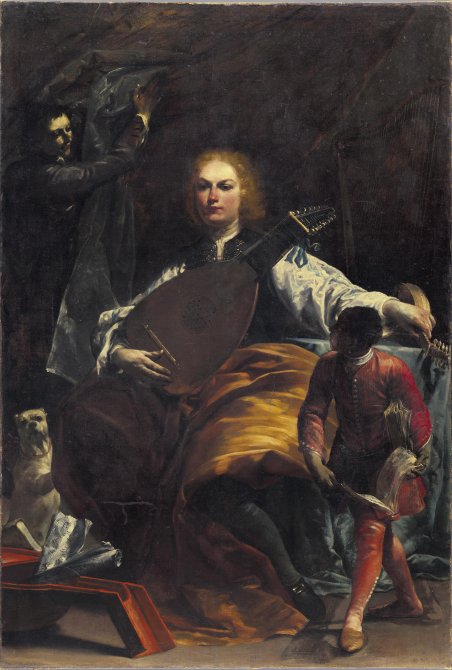
Giuseppe Maria Crespi
Portrait of Count Fulvio Grati
ROOM 22
Crespi was a prominent late baroque artist in Bologna who specialised in genre painting, to which he contributed fresh nuances such as a bolder palette, possibly influenced by the works of Titian and Veronese whom he may have met on his trip to Venice. The patronage of Ferdinando de’ Medici enabled him to study the family’s Dutch and Flemish painting collection, which also had an impact on his art.
This is not the only work where Crespi paints a scene with instruments, so it is thought that he may have had links with Bologna’s musical circles and that he himself, like the sitter here, was a music lover. From the number of Baroque paintings depicting small concerts and still lifes or interiors featuring musical instruments, we can deduce that music had become a very widespread pastime in Italy. As of the late 17th century, Bologna was the nerve centre of chamber music, where a composition is interpreted by a small number of instruments and, as the name suggests, is more intimate than the kind of music written for large concerts.
In this large-scale canvas, Crespi portrays Count Fulvio Grati, who was a member of Bologna’s nobility. Grati, who occupies the middle of the composition, has his arm around a large Baroque lute, on which the painter has depicted the neck, headstock, tailpiece and above all the rosette, in intricate detail. His outstretched arm holds a mandolin which is resting on a table covered in a blue cloth. This instrument was very popular in 17th-century Italy. Behind him in the shadow is the bare outline of a harp. The Count is accompanied by two assistants, one of whom is drawing a heavy curtain, giving the scene the appearance of a small theatre. In the foreground, an ornately- dressed page is holding two music albums. From the pentimenti (or traces of earlier painting) visible to the naked eye, it would appear that the painter corrected this page’s position. Rounding off this interior scene is a dog looking at the viewer and the detail of an exceptional still life featuring objects connected to music, such as a book and several scores in a lute case lying on the floor.

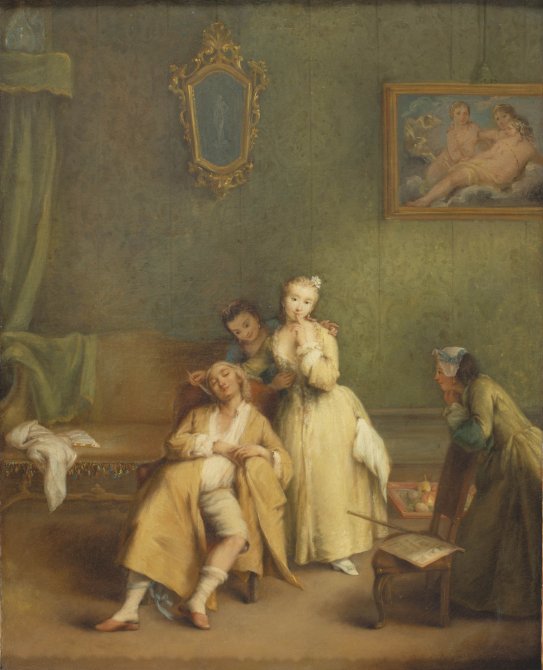
Pietro Longhi
The Tickle
ROOM 16
Pietro Longhi, whom french historian André Chastel called “the Molière of painting”, was a close observer of the society of his day, whose customs he reflected in his oil paintings. The Venetian salons of the upper classes were a recurring theme in his work, as we can see in this canvas where an insignificant anecdote becomes a subject worthy of painting.
The link between Pietro Longhi’s painting and the theatre, and in particular with the work of famous playwright Carlo Goldoni, is obvious. The artists were contemporaries and, from their respective standpoints, drew a true picture of 18th-century Venetian life, featuring the nobility, the poor, beggars and ordinary people.
Longhi organises this work like the scene from a play. A powerful light shines in on the four figures who are positioned as if on a stage from which the girl puts her finger on her lips asking for audience complicity in not waking the young man up. The harmless prank, closely observed by two other female figures who are also in cahoots, is a fun way to pass the time of day. Fast asleep, the young man having his neck tickled with a feather is sprawled in a somewhat inelegant but credible pose for this private moment of relaxation.
The interior shows what might be a room in any Venetian palace, refurbished to suit the fashions of the day. The walls are covered in a delicate green cloth reminiscent of the water in the canals and with heavy matching curtains that shut out the light. The result is a pleasant and intimate setting which beckons the young man to repose. The furniture and objects in the room follow the Rococo style in vogue during Pietro Longhi’s day, and reflect the tastes and trends of its residents. The tones are soft and subdued, the gold trim subtle and the design marked by an undulating movement, as seen in the chair legs on the right or the detailed finish of the sofa further in the background. Venetian high society’s taste for interior design and decoration is apparent in particulars like the figure in the gold frame in the virtual centre of the picture, decorated with rockeries and coquilles, to match the rest of the room’s furnishings and into which the characters depicted fit perfectly.

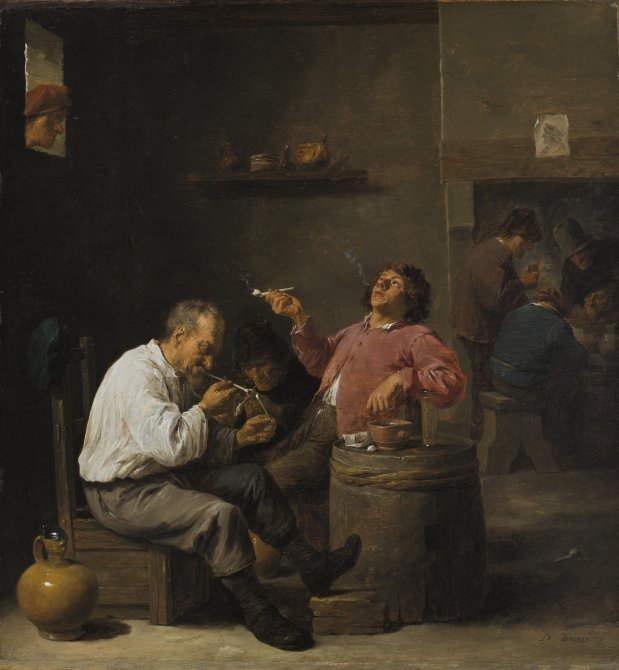
David Teniers II
Smokers in an Interior
ROOM 25
In northern Europe, works depicting scenes from everyday life were very popular with a burgeoning and affluent bourgeoisie. In these works, artists depict people playing cards, taking part in domestic chores or countryside festivities, and drinking or smoking as is the case here. Teniers was one of the major figures in 17th-century Flemish painting, and although here he borrowed his subject matter from Adriaen Brouwer, this is a fine example of the artist’s composition and treatment of space. It is also outstanding for the colour of the characters’ clothing and the representation of objects which make up a still life in their own right. Also interesting is the man’s head looking down on the scene from a window through which light enters from the outside.
Tobacco came from America where it was used for medicinal purposes, and representations are known of indigenous people smoking the leaves. However, it did not arrive in Europe, and more specifically in Spain, until the 16th century, where it was introduced precisely by expeditionaries returning home. Some of the first processing facilities to be set up in Spain were located in Seville. Europeans turned the act of smoking into a social and leisure activity, and tobacco consumption was widespread on the old continent in the 17th century. In this painting, the figures in the foreground are enjoying the delights of pipe-smoking and free time in the tavern, while in the background we see another group of men drinking and playing cards. The artist takes pleasure in showing how the figure in the pinkish jacket who is part of the main group, enjoys the puff he has just taken from his pipe, the smoke from which fills the air.
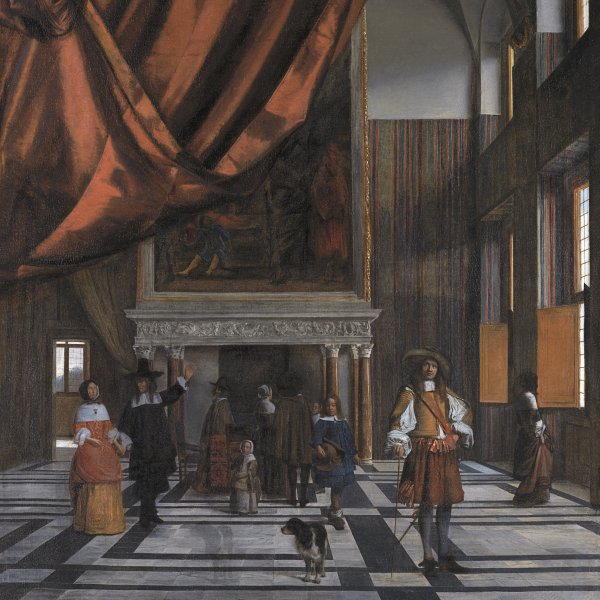
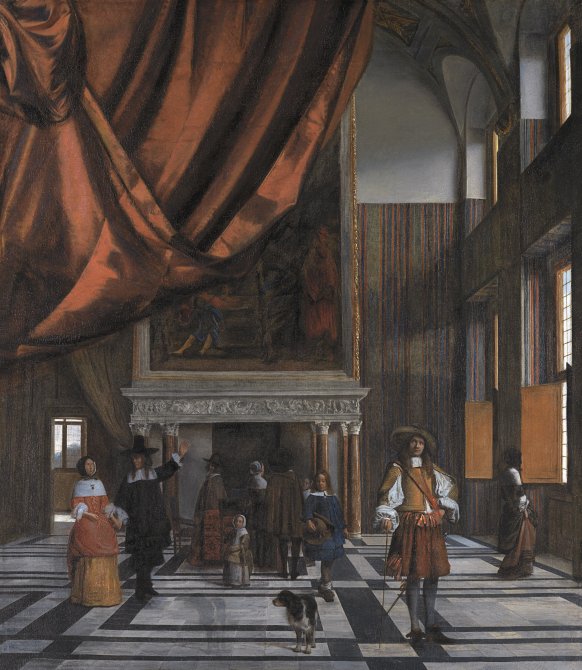
Pieter Hendricksz. de Hooch
Interior of the Council Chamber of Amsterdam Town Hall
ROOM 25
The Amsterdam town hall depicted in Pieter de Hooch’s painting, today known as the Royal Palace, is located in one of the liveliest squares of the Dutch capital, Dam. The building, with its irregular shape, dominates the urban space which it shares with Nieuwe Kerk and the Monument to the Liberation obelisk.
The exterior of this public building and the vicinity was a regular subject in the paintings of 17th-century Dutch artists, who used the square, the town hall and the surrounding buildings as models for their oil paintings. However, there are fewer works depicting the building’s interior, hence the significance of this canvas which is a record of one of its most iconic rooms and a symbol of the city’s power, as well as testimony to a day of cultural leisure in Amsterdam in the first half of the 1660s.
The room painted by Hooch was the meeting place for the city’s burgomasters and was open to visitors when meetings and sessions were not underway. Today, the interior has changed little except for the sequence of lower shutters that no longer exists and the wall hangings that are not there now either. Like the tourists of today, various groups of people can be seen milling on this historical site, having come to admire the decoration and works of art hanging there, or simply to see the city’s place of government. The visitors include couples like the one on the left, families like the one admiring the ensemble around the fireplace, or individuals on their own like the boy removing his hat as a sign of respect or the woman looking through one of the windows. One of the most striking focal points is the smartly-dressed gentleman in the foreground with a sword, who is leaning on a delicate stick and absorbed in contemplation of the large painting opposite. This is an oil painting by Govert Flinck entitled Marcus Curius Dentatus Refusing the Gifts of the Samnite Ambassadors. A companion to The Bravery of Consul Fabritius in the Camp of King Pyrrhus by Ferdinand Bol, which is the painting we can see, both allude to the incorruptibility and heroism that should be exercised by city officials in their duties, which inside the Town Hall take on an obvious significance, sending a convincing message to those that abide within, reminding them of the moral virtues of uprightness that should characterise their terms of office.
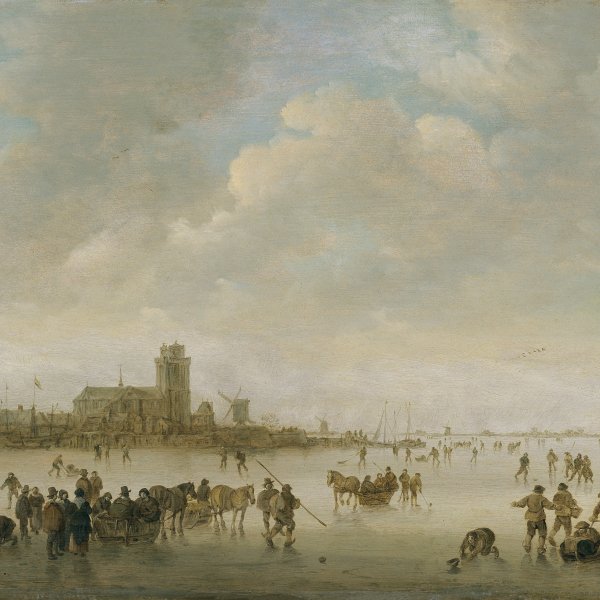
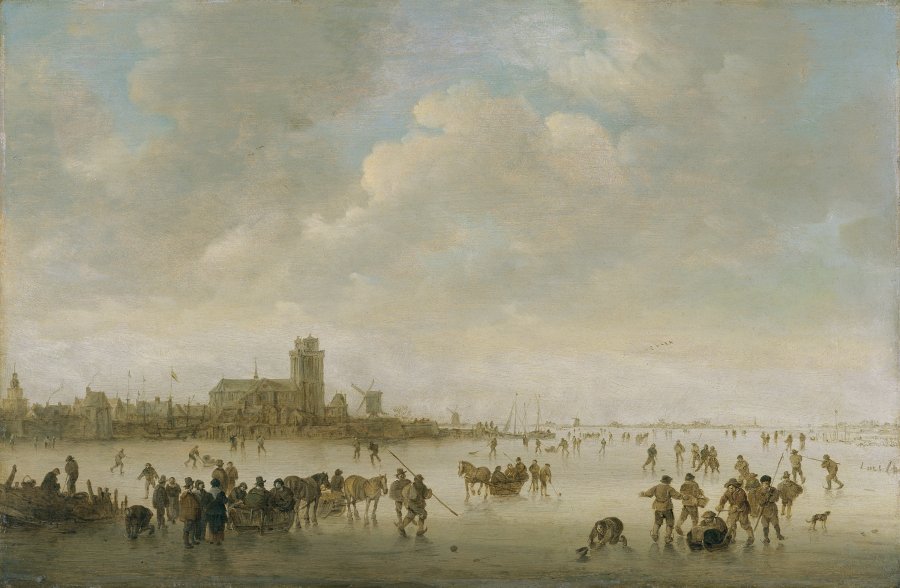
Jan Josephsz. van Goyen
Winter Landscape with Figures on Ice
ROOM 23
Jan Josephsz. Van Goyen was a prominent Dutch landscape artist. This panel, which belongs to his mature work, is defined by its broad horizons, based on horizontal lines, and by its inclusion of a strip of land on which the artist locates the city. The city shown in this picture has been identified as Dordrecht and depicts houses, a church and a number of windmills typical of the Low Countries. The church that looms up beside the river is the Grote Kerk, seen from its north side. It caught fire in 1457 and was rebuilt between 1460 and 1502. The artist emphasises its basilical ground-plan and tower, which lacks the typical spire that would usually round it off. The large frozen river is the Oude Maas, which dominates the painting, along with numerous figures and boats comprising the various scenes that make up the work. The painting is set in winter when the river has frozen over and the people are caught on canvas engaged in different activities at a moment of fun and leisure: some are fishing in the frozen river, others are sledging in groups or skating, and both younger and older people are playing with sticks reminiscent of present-day hockey. Although this sport as we now know it only dates back to the 19th century, drawings and paintings like this show that a similar kind of game was played on frozen ground in both the Low Countries and in Britain. Skating was also common in 17th-century Netherlands, both out of necessity and for fun. Also interesting is the simplicity of the skates worn by the protagonists, which are simply sharpened bones tied to the feet with leather strips.

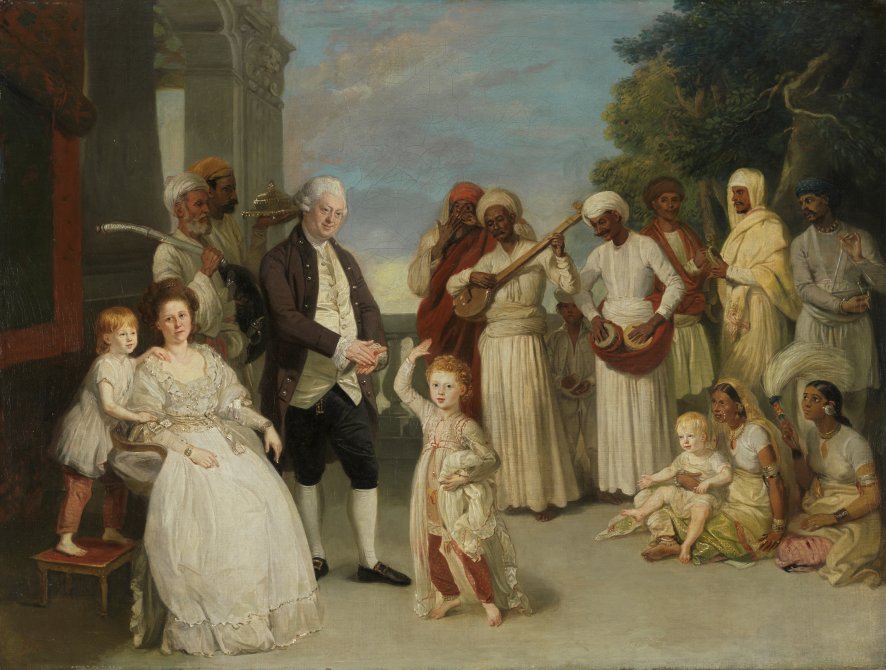
Johann Zoffany
Group Portrait of Sir Elijah and Lady Impey
Not on display
Johan Zoffany was an english artist who specialised in what were called “conversation pieces”, which gained widespread recognition in his day. He was then commissioned by the British Queen to paint Tribuna of the Uffizi in Florence. Unfortunately, when he returned from Italy, tastes in art had changed and his compositions no longer found an appreciative audience. This led him to set out for India in search of new clients. There he found a large number of high-ranking officials and members of the British colonial elite who still enjoyed his characteristic work. On this canvas, the artist portrays Sir Elijah and Lady Impey celebrating a little party with three of their seven children. The family is having fun listening to music and watching the children dance. We can see a girl dancing in Indian dress, probably their daughter Marian, while Sir Elijah claps along in encouragement. The little girl is raising her right hand in a characteristic Indian dance move. On the right, the artist has painted a group of six musicians in exotic turbans and light-coloured garments, each with a different instrument: the one on the left is playing a mouth harp, which was popular both in India and Europe; beside him is a musician with a tānpara, a string instrument similar to a lute with a long neck and hemispherical soundboard used to accompany song; the smiling musician beside him is beating a tābla, a double-headed membrane instrument and the most popular in India, made from a pair of drums and supported by a terracotta-coloured cloth tied around his hips; next is a violinist who appears alongside another musician playing a little tambourine known in India as a kānjira; and finally, a musician holding a triangle. Behind them is a child of unknown identity holding kārtals, of which Spanish castanets are a variation.
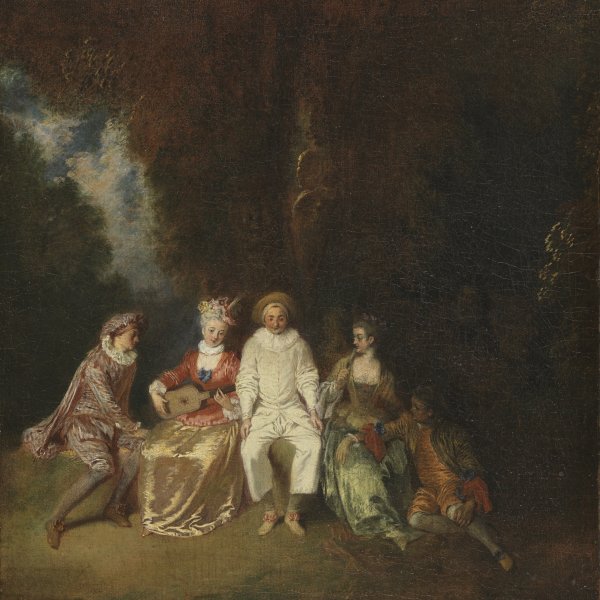
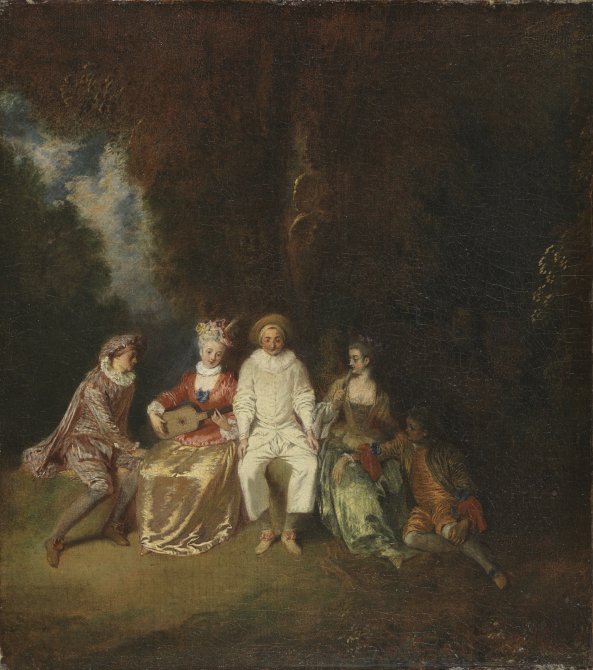
Jean Antoine Watteau
Pierrot Content
Not on display
In the clearing of a lush garden illuminated by a point of light filtering through the undergrowth, Pierrot sits at the centre of the composition looking out towards the viewer. The figure of Pierrot comes from Italian Commedia dell’Arte, and it was Watteau’s training in Paris with Claude Gillot that brought him into contact with the theatre and, more specifically, with the Italian performers then fashionable in the city. This was a recurring theme in Watteau’s oeuvre, both paintings and a series of drawings. Here Pierrot has been adapted to French tastes, losing his original roguishness and depicted as a moon-loving dreamer with a certain sadness about him. The work’s title may refer to the lyrics of a popular song “How happy Pierrot would be if he only had art to please you”.
Pierrot is flanked by two female figures elegantly dressed in the Rococo style that had emerged in Versailles and Paris. Defined by a taste for bright colour, profuse and exuberant silk, satin and velvet fabrics, garments were adorned with frills and bows and accompanied by highly elaborate hairstyles. Ladies moved their fans, which were trimmed with mother-of-pearl and lace, according to a secret code of gestures. One of the young women looks spellbound at Mezzetin, who is sitting at the other end, and holds her closed fan resting under her chin as if to say: “Do you love me?”. Mezzetin, however, fails to return her gaze and is instead absorbed by the other female figure who is livening up the evening with guitar music. This instrument, typical of the 17th and 18th centuries, was very popular in Spain, but appears to have been introduced into France by Italian fair performers. Watteau was the quintessential master of French Rococo and this early oil painting belongs to a group of works known as fêtes galantes, a term coined by the Académie precisely to designate this artist’s canvases which narrate scenes where several characters enjoy music, poetry and courtship, usually in outdoor scenes.

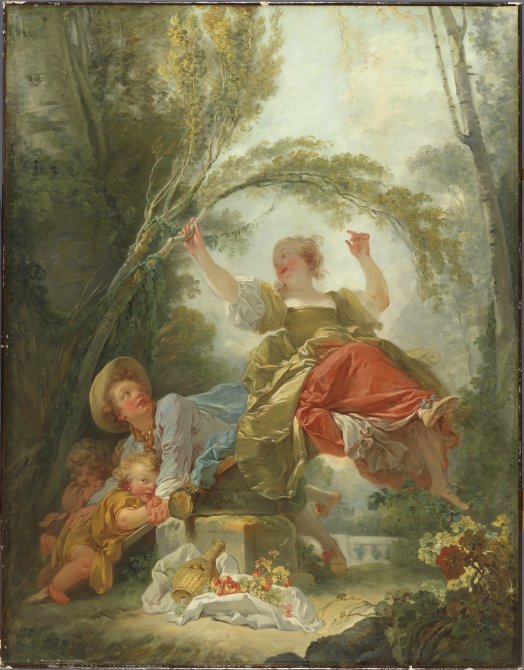
Jean-Honoré Fragonard
The See-Saw
ROOM 24
With Boucher, Chardin and Watteau, Fragonard is one of the most outstanding French painters of the 18th century and a major exponent of fête galante, a term that refers to a type of work characterised by bright colour and lively subject matter. The period was marked by a preference for genre scenes in interiors or merrymaking in gardens and woodland, where richly-dressed characters at leisure enjoy music, strolling, poetry and flirting. In keeping with the hedonism of this kind of painting, it is common to find series representing different seasons, with diversions associated with the manifestations of nature at each given moment. Religious themes or history paintings are relegated to a more secondary level. This kind of work in small formats was commissioned by the nobility and aristocracy and is in tune with the Rococo tastes that permeated palaces, manor houses and the decorative arts of the day.
This early work, where Fragonard already shows an interest in two of his favourite themes, namely love and nature, depicts people at play. As if in an allegory of passion, the young woman is enjoying being right up high in the air where she has been propelled by the young man who is applying weight to the other end of the see-saw with the assistance of two children who could be compared to little cupids watching over the love between the young couple. The scene takes place in a leafy garden where lush nature is complemented by a still life in the foreground depicting exquisite fruit.
The artist plays masterfully with the light and with bold colours to construct the figures. The handling of the pleats and reflections that emanate from the diaphanous fabrics add lightness and movement to the figure of the young woman who appears to be hanging in the air.
The canvas forms the pair to a painting in the Toledo Museum of Art in Ohio called Blind Man’s Buff and can today be considered the clearest precedent for Fragonard’s famous work The Swing, now in the Wallace Collection in London.
